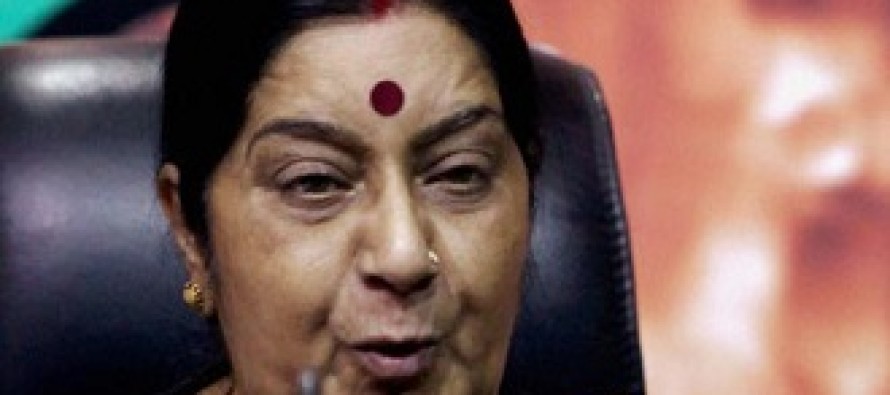“Saree diplomacy” between Bangladesh and India

On 25th June, India’s Minister for External Affairs Ms. Sushma Swaraj visited Dhaka for 38 hours. Ms. Swaraj stated that the Indian government would work with the Sheikh Hasina government in Bangladesh to further strengthen relations and at the same time by meeting with the Chairperson, Bangladesh Nationalist Party (BNP) , the largest opposition party outside the parliament , she showed her prudence and sense of pragmatism.
The people of Bangladesh did not expect the first foreign visit by Swaraj to resolve pending issues with India; but they are the respective citizens’ issues because these issues – such as the Teesta Water Sharing Agreement and the Land Boundary Agreement – directly affect the people on the ground. Her telephone call to the Chief Minister of West Bengal Mamata Banerjee before the visit reflected the Modi government’s keen desire to reach a consensus with the various stakeholders in India to resolve the issues.
The people of Bangladesh believe that the Modi government has an excellent opportunity to build a new era of relationship with Bangladesh – similar to what Bangladesh’s Prime Minister Sheikh Hasina, did during her New Delhi visit in January 2010.
The Hasina government had cooperated in removing the threat of insurgency to India’s northeastern states by expelling the insurgents who operated out of sanctuaries in Bangladesh. She had allowed, without a transit agreement, transit facility to the India’s northeastern states – including the transportation of heavy duty equipment for ONGC Tripura Power Company’s 727 MW gas-based project located at Palatana, and the transportation of 10,000 tons of food grains for Tripura through its territory.
However, in return, Bangladesh did not get what India has promised and this has been a severe disappointment for Bangladeshi citizens. The trust-deficit with India remains high in Bangladesh and it needs to be removed to usher in a new invigorated bilateral relationship.
Swaraj said India’s development could not be complete and sustainable unless they successfully partnered with their immediate neighbours. It is noted that the 2011 Indo-Bangladesh Framework Agreement on Cooperation and Development opened up possibilities in cooperation on bilateral, sub-regional and regional level on areas such as, water, energy, food security and environmental safety.
Furthermore, the Modi government may take initiative in constituting a sub-regional unit comprising Bangladesh, Bhutan, Nepal, and the northeastern states of India. If their economy is integrated to the region, it could turn into hub of economic activities and when people have money into their pockets, they are happy and are not lured towards militancy or insurgency.
Bangladeshi people are hopeful that Indian Prime Minister Narendra Modi’s invitation to the SAARC leaders for his swearing-in ceremony in New Delhi, on 26 May, will generate productive spirit of regional cooperation in which South Asia can be an economic powerhouse.
Saree diplomacy:
It is fascinating to note that in Dhaka Ms. Swaraj met with Prime Minister Sheikh Hasina, parliamentary opposition leader Rowshan Ershad and the BNP Chairperson, Begum Khaleda Zia, the head of the largest political party outside the parliament. All are female leaders by coincidence,
Ms. Swaraj was accompanied to Dhaka by India’s Foreign Secretary Ms. Sujatha Singh (she served as India’s High Commissioner to Australia), and a key officer (Joint Secretary) who deals with Bangladesh affairs in the Indian Foreign office, Ms. Supriya Ranganathan. On the Indian all three are also females.
It was reported that during the meeting with the leaders, saree gifts were exchanged among them. In India, “Jamdanee” and “Tangail” sarees are favourite while in Bangladesh Indian –made “Kanchibaran” and “Mysore silk” sarees are popular.
Accordingly in the diplomatic circle, a new term “ saree diplomacy” has been coined relating to Bangladesh-India relations.
Other forms of diplomacy:
From the early years China has used sports as an important role in diplomacy China started “pingpong diplomacy” in 1971 to engage US –China relations. It may be recalled that he U.S. Table Tennis team was in Nagoya, Japan in April 1971 for the 31st World Table Tennis Championships when they received an invitation to visit China.
On April 10, 1971, the team and accompanying journalists became the first American delegation to set foot in the Chinese capital. Within one year President Nixon visited Beijing and met the Chinese leader Mao Ze Dong. Now many analysts say China use “Cheque-book diplomacy” to strengthen its relations with all the countries across the world including Bangladesh.
India and Pakistan used “Cricket” or “Fruit” diplomacy” to ease their relations. It is noted that Indira Gandhi sent delicious “Lichis” from Meerat to President Zia ul Haq of Pakistan who in return sent famous mangoes “Anaratul” to Indira Gandhi. To witness the Cricket World Cup Pakistan’s Prime Minister Yusuf Gilani came to India which was termed as “cricket diplomacy”.
Conclusion:
Ms. Sushama’s visit underscored one fact in Indo-Bangladesh relations. Women’s role in politics and saree diplomacy have found very prominent place. We all hope that South Asia, under the new strong and imaginative leadership of India, could contribute to translating that into reality of 21st century as “Asian century” and Bangladesh will fully cooperate with India to this end.


